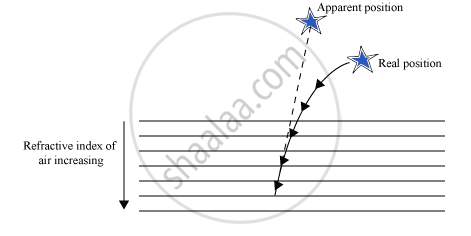Advertisements
Advertisements
प्रश्न
Why do stars seem higher than they actually are? Illustrate your answer with the help of a diagram.
उत्तर
Stars seem higher than they actually are because of the phenomenon of atmospheric refraction. This can be understood with the help of given diagram. When the light from a star descends to the earth's surface, it passes through the different layers of the atmosphere. The atmospheric air at higher levels is rarer and the air near the earth's surface is denser, and the light from the star bends more sharply when it passes through the denser layer of air.

APPEARS IN
संबंधित प्रश्न
What is atmospheric refraction? Use this phenomenon to explain the following natural events:
Twinkling of stars
Draw diagrams to illustrate your answers.
Fill in the following blank with suitable word:
We can see the sun about ................ minutes before the actual sunrise and about ................ minutes after the actual sunset because of atmospheric ................
What is atmospheric refraction? What causes atmospheric refraction?
The atmospheric refraction of light causes the twinkling of:
(a) planets only
(b) stars only
(c) planets and stars
(d) stars and satellites
Due to atmospheric refraction of sunlight, the time from sunrise to sunset is lengthened by about:
(a) 6 minutes
(b) 2 minutes
(c) 4 minutes
(d) 5 minutes
A student claims that because of atmospheric refraction, the sun can be seen after it has set, and the day is, therefore, longer than if the earth had no atmosphere.
Do you think that the students conclusion is correct?
Explain why the planets do not twinkle but the stars twinkle.
The air layer of the atmosphere whose temperature is less than the hot layer behave as optically:
Refraction of light by the earth’s atmosphere due to variation in air density is called ____________.
How does refraction take place in the atmosphere? Why do stars twinkle but not the planets?
